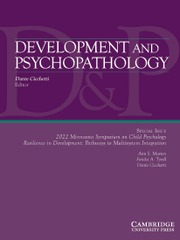Crossref Citations
This article has been cited by the following publications. This list is generated based on data provided by
Crossref.
Bailey, Susan
1999.
The interface between mental health, criminal justice and forensic mental health services for children and adolescents.
Current Opinion in Psychiatry,
Vol. 12,
Issue. 4,
p.
425.
Vance, Alasdair L.A.
Velakoulis, Dennis
Maruff, Paul
Wood, Stephen J.
Desmond, Patricia
and
Pantelis, Christos
2000.
Magnetic Resonance Spectroscopy and Schizophrenia: What have we Learnt?.
Australian & New Zealand Journal of Psychiatry,
Vol. 34,
Issue. 1,
p.
14.
RÖNKÄ, ANNA
ORAVALA, SANNA
and
PULKKINEN, LEA
2002.
“I met this wife of mine and things got onto a better track” Turning points in risk development.
Journal of Adolescence,
Vol. 25,
Issue. 1,
p.
47.
Hagan, John
2002.
Class and crime in war-time: Lessons of the American Vietnam war resistance in Canada.
Crime, Law and Social Change,
Vol. 37,
Issue. 2,
p.
137.
SULLIVAN, MERCER L.
2002.
Exploring Layers.
Sociological Methods & Research,
Vol. 31,
Issue. 2,
p.
255.
Deren, S.
Oliver-Velez, D.
Finlinson, A.
Robles, R.
Andia, J.
Colón, H. M.
Kang, S.-Y.
and
Shedlin, M.
2003.
Integrating Qualitative and Quantitative Methods: Comparing HIV-Related Risk Behaviors Among Puerto Rican Drug Users in Puerto Rico and New York.
Substance Use & Misuse,
Vol. 38,
Issue. 1,
p.
1.
Carr, Patrick J.
2003.
The New Parochialism: The Implications of the Beltway Case for Arguments Concerning Informal Social Control.
American Journal of Sociology,
Vol. 108,
Issue. 6,
p.
1249.
Lorion, Raymond P.
and
Sokoloff, Harris
2003.
Developmental Assets and Asset-Building Communities.
p.
121.
DAVIES, PATRICK T.
and
CICCHETTI, DANTE
2004.
Toward an integration of family systems and developmental psychopathology approaches.
Development and Psychopathology,
Vol. 16,
Issue. 03,
Enebrink, Pia
Cederborg, Ann-Christin
Carlqvist, Monica Ryd
and
Gumpert, Clara H.
2006.
Clinical work with antisocial behaviour in boys: Narrative interviews with clinical teams in Swedish child- and adolescent psychiatry.
Children and Youth Services Review,
Vol. 28,
Issue. 6,
p.
654.
Costello, E. Jane
Foley, Debra L.
and
Angold, Adrian
2006.
10-Year Research Update Review: The Epidemiology of Child and Adolescent Psychiatric Disorders: II. Developmental Epidemiology.
Journal of the American Academy of Child & Adolescent Psychiatry,
Vol. 45,
Issue. 1,
p.
8.
March, Dana
and
Susser, Ezra
2008.
Developmental Psychopathology and Wellness.
p.
49.
Mels, C.
Derluyn, I.
and
Broekaert, E.
2008.
Social support in unaccompanied asylum‐seeking boys: a case study.
Child: Care, Health and Development,
Vol. 34,
Issue. 6,
p.
757.
Pagani, Linda S.
Japel, Christa
Vaillancourt, Tracy
and
Tremblay, Richard E.
2010.
Links Between Middle-Childhood Trajectories of Family Dysfunction and Indirect Aggression.
Journal of Interpersonal Violence,
Vol. 25,
Issue. 12,
p.
2175.
Guerra, Nancy G.
Williams, Kirk R.
and
Sadek, Shelly
2011.
Understanding Bullying and Victimization During Childhood and Adolescence: A Mixed Methods Study.
Child Development,
Vol. 82,
Issue. 1,
p.
295.
Thylstrup, Birgitte
2011.
Numbers and narratives. Relations between patient satisfaction, retention, outcome and program factors in outpatient substance abuse treatment.
Nordic Studies on Alcohol and Drugs,
Vol. 28,
Issue. 5-6,
p.
471.
SULLIVAN, CHRISTOPHER J.
2011.
THE UTILITY OF THE DEVIANT CASE IN THE DEVELOPMENT OF CRIMINOLOGICAL THEORY*.
Criminology,
Vol. 49,
Issue. 3,
p.
905.
Wright, Margaret O'Dougherty
Fopma-Loy, Joan
and
Oberle, Katherine
2012.
In their own words: The experience of mothering as a survivor of childhood sexual abuse.
Development and Psychopathology,
Vol. 24,
Issue. 2,
p.
537.
Wright, Margaret O’Dougherty
and
Masten, Ann S.
2015.
Youth Resilience and Culture.
Vol. 11,
Issue. ,
p.
3.
Wachs, Theodore D.
2015.
Handbook of Child Psychology and Developmental Science.
p.
1.

